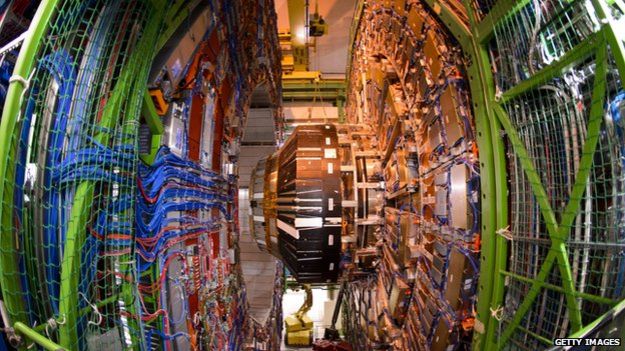The Large Hadron Collider has restarted, with protons circling the machine’s 27km tunnel for the first time since 2013.
Particle beams have now travelled in both directions, inside parallel pipes, at a whisker below the speed of light.
Actual collisions will not begin for at least another month, but they will take place with nearly double the energy the LHC reached during its first run.
Scientists hope to glimpse a “new physics” beyond the Standard Model.
Rolf Heuer, the director-general of Cern, which operates the LHC, told engineers and scientists at the lab: “Congratulations. Thank you very much everyone… now the hard work starts”.
Cern’s director for accelerators and technology, Frédérick Bordry, said: “After two years of effort, the LHC is in great shape.
“But the most important step is still to come when we increase the energy of the beams to new record levels.”
The beams have arrived a week or so later than originally scheduled, due to a now-resolved electrical fault.
The protons are injected at a relatively low energy to begin with. But over the coming months, engineers hope to gradually increase the beams’ energy to 13 trillion electronvolts: double what it was during the LHC’s first operating run.
After 08:30 GMT, engineers began threading the proton beam through each section of the enormous circle, one-by-one, before completing multiple full turns. It was later joined by the second beam, in parallel.
The experiment teams have already detected “splashes” of particles, which occur when stray protons hit one of the shutters used to keep the beam on-track. If this happens in part of the pipe near one of the experiments, the detectors can pick up some of the debris.
“It’s fantastic to see it going so well after two years and such a major overhaul of the LHC,” said Prof Heuer.
“I am delighted and so is everyone in the Cern control centre – as are, I’m sure, colleagues across the high-energy physics community.”
Big unknowns
Physicists are frustrated by the existing Standard Model of particle physics. It describes 17 subatomic particles, including 12 building blocks of matter and 5 “force carriers” – the last of which, the Higgs boson, was finally detected by the LHC in 2012.

Prof Tara Shears, from the University of Liverpool, works on one of the LHC’s four big experiments that will soon recommence their work, slamming protons together and quantifying the fallout.
“Of course in every particle physics experiment we’ve ever done, we’ve been wanting to make a big, unknown discovery,” Prof Shears told BBC News.
“But now it’s become particularly pressing, because with Run One and the discovery of the Higgs, we’ve discovered everything that our existing theory predicts.”
In order to explain several baffling properties of the universe, things beyond the Standard Model have been proposed – but never directly detected.
These include dark energy, the all-pervading force suggested to account for the universe expanding faster and faster. And dark matter – the “web” that holds all visible matter in place, and would explain why galaxies spin much faster than they should, based on what we can see.


